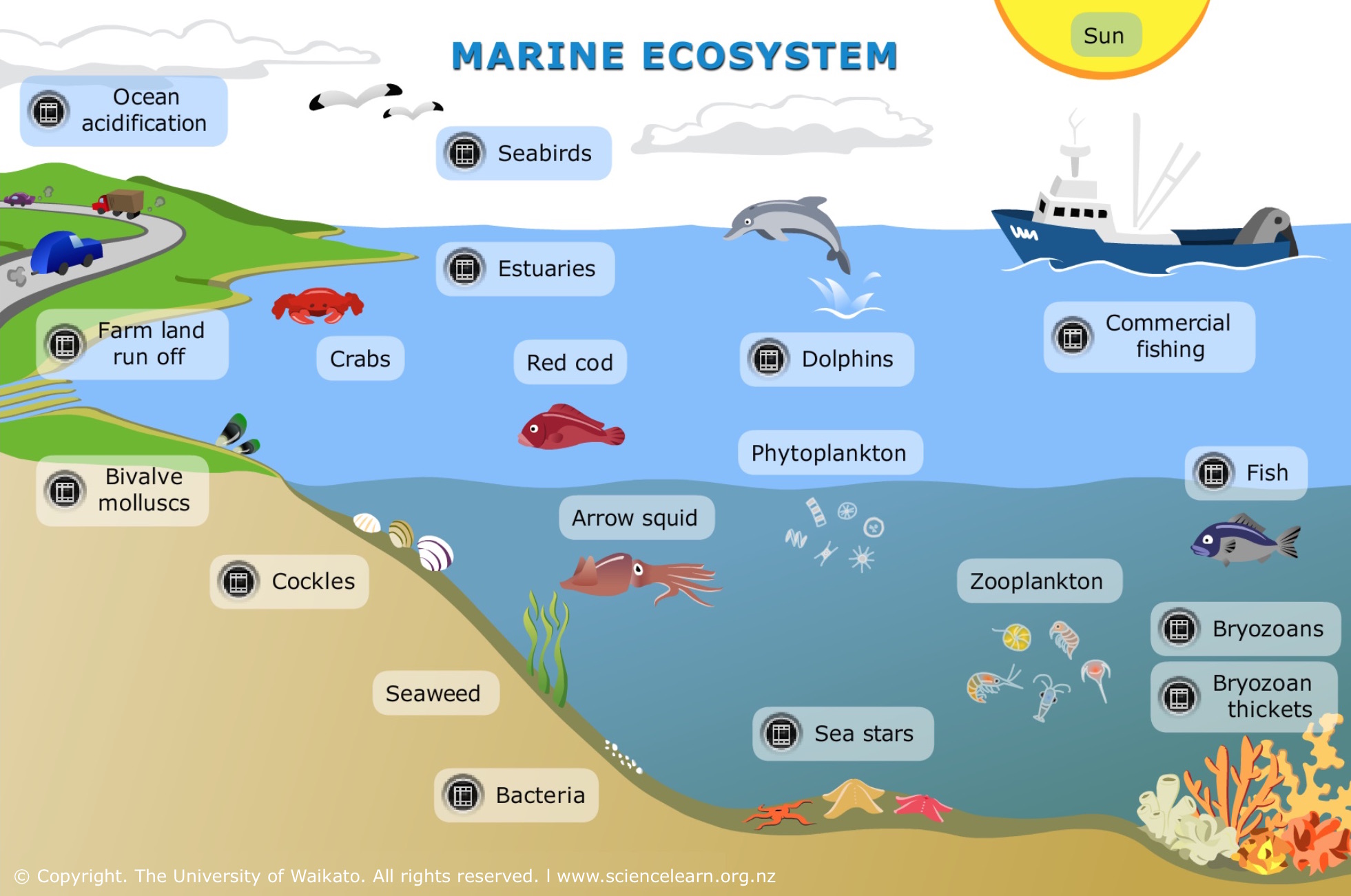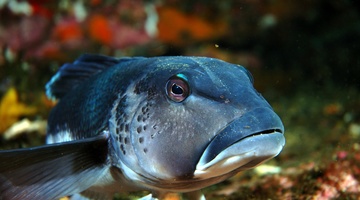Explore this interactive diagram to learn more about life in the sea. Click on the different labels to view short video clips or images about different parts of the marine ecosystem.

Clicking on the labels will bring up short video and images that can be used to explore marine ecosystems in greater detail.
Use this interactive with the article Marine food webs.
Excellent interactive for all, it would work brilliantly for all learners regardless of all reading abilities!
Year 5/6 teacher
Transcript
Ocean acidification
ASSOC PROF ABBY SMITH
When the oceans absorb carbon dioxide then they... it changes their chemistry a little. It drives a carbon cycle, which involves a series of fairly simple chemical equations, and it causes the pH [level] of the sea to go down. That means the sea becomes a little more acidic. Now, if we were only producing a little bit of carbon, then the ocean might only become a little more acidic and that would be OK, but we are producing enormous amounts of carbon, and the ocean is absorbing more carbon more quickly than it ever has ever in the past, and it is changing in terms of its pH very, very rapidly, and critters living in the water just can't adjust to that.
Seabirds
ASSOC PROF STEPHEN WING
If you removed cockles from a marine food web, it would have dramatic effects on all the consumers, all of the animals that rely on their services. And we can guess that for New Zealand, but we know that from some systems where this has actually happened. And so there are several places around the world where there have been huge die-offs of bivalves – mussels, clams and so on – and this has had effects all the way up through the food web to the highest levels, to sea birds that feed on little cockles or little clams, all the way up to sharks and large fish. When you disturb a food web, at any place but particularly near the bottom, this can have sort of reciprocating effects all the way up the food web.
Farm land run-off
DR CANDIDA SAVAGE
To try and promote intensive farming practices, we fertilise more than we require on the fields, and so there is some left-over nutrients that can then carry into water sources, into streams and eventually downstream into estuaries. What it does is it promotes growth of the plants, of the seaweeds and of the algae. And so a little bit of enhanced nutrients can be good, and we see improved growth of several organisms, but if you have too much of that, it can start causing negative effects, and there are some threshold levels beyond which certain estuaries can't cope with that increased nutrient loading.
Estuaries
DR CANDIDA SAVAGE
Estuaries are important areas, not only from a human perspective, but they are also important nursery areas. So a lot of fish organisms will come and use estuaries when they are at young stages of their life cycle, and so they form an important nursery habitat. They are also crucial filters for filtering contaminants from land before it goes out into the coastal zone, so they have an important biogeochemical role as well as a nursery habitat role.
Dolphins
ASSOC PROF STEPHEN WING
Dolphins are classified as mammals, and mammals are one class of vertebrates, which are a group, a subphylum, in the phylum chordata. So the role that dolphins play in the food web is that they are an apex predator. Dolphins feed on fish and so they are ultimately supported by the cockles and all the primary producers.
Commercial fishing
ASSOC PROF STEPHEN WING
We use the marine environment for food. People go out fishing, and they collect fish and shellfish and different organisms for food, and this has occurred on relatively small scales through history. But through the advent of commercial fishing, the amount of food being taken out of the ocean has risen, and increasingly, it’s been more fish being removed than the populations can replace, and so there have been some examples of large stocks of fish that have collapsed under too much exploitation going on.
Bivalve molluscs
ASSOC PROF STEPHEN WING
A cockle is a bivalve mollusc. The molluscs are things like snails and mussels, and even octopus are a type of mollusc. But bivalve molluscs have, as the name says, they have two valves – bi is two, mollusc is the shell. And so things like clams and mussels are bivalve molluscs. They are very, very common in inlets and estuaries all around the country, and people assume that they will always be there doing their job for the estuaries.
Fish
DR CANDIDA SAVAGE
So fish and I guess a number of organisms can be classified as either generalist feeders or specialist feeders, and by that we mean, if it’s a generalist, it often can eat fairly broad types of items and dietary items. So it will generally eat cosmopolitan species, so it will be eating a bit of polychaetes or worms, a bit of bivalve, maybe some smaller crustaceans and so on. And then you've got these more specialist feeders that often have mouth parts especially adapted for eating a particular diet, and so they will have a narrower niche of items that they eat.
Cockles
ASSOC PROF STEPHEN WING
Cockles play a very important role in the marine food web because they clean the water, and they make it so that phytoplankton don't bloom or become too abundant, and they keep the water from going eutrophic or full of phytoplankton. What happens when the water becomes full of phytoplankton is they can suck up all the oxygen and you can actually get fish kill, so cockles sort of dampen or reduce the possibility that you get these sorts of bad conditions occurring.
Bryozoans
ASSOC PROF ABBY SMITH
Bryozoan colonies don't really look like animals – they look a little like little trees or flowers or something – but when you actually look at the level of the individual, they do look like an animal. They are a little worm with a nose that has tentacles around the outside, and they sit inside their little box, and when they think it’s a good idea, they open the door and poke their tentacles out and catch something. So they aren't particularly different from other animals you know. They’re just really, really small, and the colonies they make by gluing together look a little like plants.
Bacteria
DR CANDIDA SAVAGE
There is a lot that's living both out in the water but also in the sediments that we don't see with our bare eyes, and what we realise is that these microorganisms are a crucial component of a food web, so by that I mean the bacteria and the small microscopic organisms that we can't see, and they are performing a vital role in terms of cycling of nutrients and also just maintaining a healthy ecosystem.
Sea star
DR MILES LAMARE
Starfish are predators, and they’re probably the most important predator in the shallow ecosystem – so the depths where we would dive or swim. They eat basically anything that they can come across, and they have a major role in keeping the numbers of other organisms down, other species down, such as mussels.
[NOTE: Starfish are now referred to as sea stars because the starfish is not a fish, it's an echinoderm.]
Bryozoan thickets
ASSOC PROF ABBY SMITH
Bryozoans are important in a kind of ecosystem way. They provide a location for biodiversity. And so particularly we think that, in New Zealand's mid-shelf waters, they are providing a nursery ground for fish and that the baby fish can hide somewhere, and it would be a bad idea to lose them.
Phytoplankton
Phytoplankton are important primary producers in the marine food web. They are microscopic, single-celled organisms that float freely in the ocean. They rely on energy from the sun for photosynthesis and are therefore most commonly found less than 100 metres below the surface. Phytoplankton are eaten by zooplankton. These are diatoms, under the microscope. Diatoms are one of the most common types of phytoplankton.
© Public domain
Zooplankton
Zooplankton are a large, diverse group of organisms that live in the water column. Unlike most phytoplankton, they live at all depths, from the surface to the bottom. They come in many different shapes and sizes, and as the primary herbivores in the marine food web, they provide an important link between the primary producers and the carnivores.
© Public domain
The sun
Primary producers convert the Sun’s energy into food through photosynthesis. Almost all the energy used by marine organisms to make food comes from the Sun.
© Jan Gerrit Siesling, licenced through 123RF limited
Crabs
Stalk-eyed mud crabs are endemic to New Zealand. They live mostly in the low-tide zone and cannot survive out of the water for more than 8 hours. They feed on the nutritious mud that they live in. Crabs are a popular food source for many fish, stingrays and seabirds. Pictured is the New Zealand half crab, Petrolisthes elongates.
© Public domain
Red Cod
Red cod are normally found at depths of 100–300 metres and eat crabs, shrimps and small fish. They normally reach about 40–70 cm in length and are an important commercial species. (You may have had some at your local fish and chip shop!) Their catch is managed by fishing quotas but there is some concern that the fishing method (trawling) used to catch red cod is putting endangered species, such as the Hector’s dolphin, at risk.
© Seafood Industry Council, New Zealand
Arrow Squid
Arrow squid are mostly nocturnal and feed on crustaceans, small fish and sometimes other squid. They are an important food source for the endangered yellow-eyed penguin and for a number of diving birds and large fish. They are an important species for commercial fishing companies in New Zealand. This is a dorsal and ventral view of the New Zealand Arrow squid, Nototodarus sloanii.
© Darren Stevens, NIWA, Creative Commons 1.0
Seaweed
Seaweed is a type of algae and is normally grouped by colour – green, red or brown. Seaweed is a primary producer and an important source of nutrients and energy in the marine food web. Seaweed generally grows in clusters called ‘beds’, and these provide an important source of shelter for many marine species, including mussels.
© Stef Maruch, Creative Commons 2.0
Related content
Join this online citizen science project to look at marine microorganisms.



